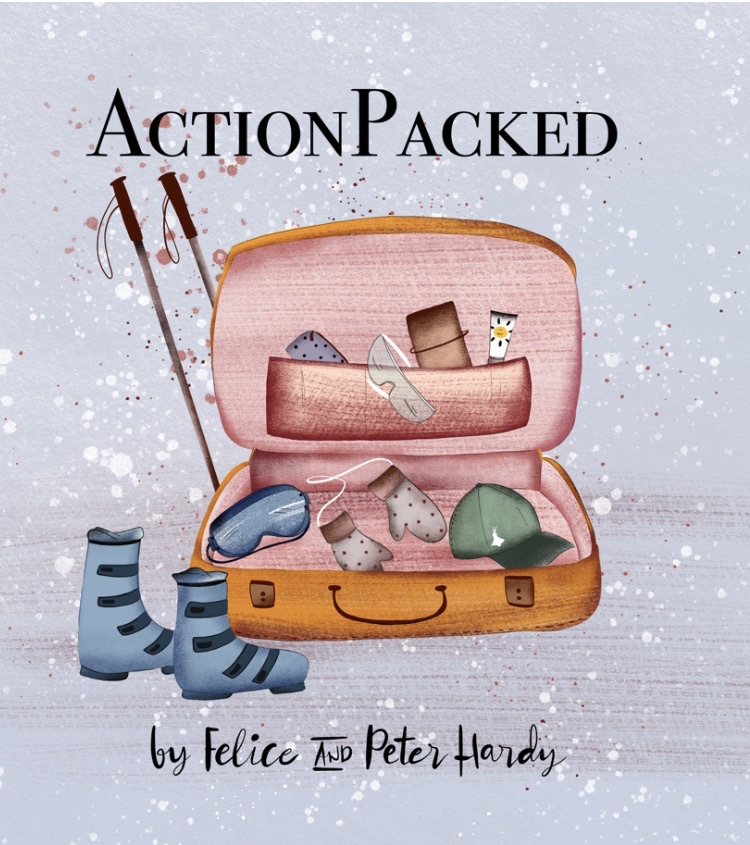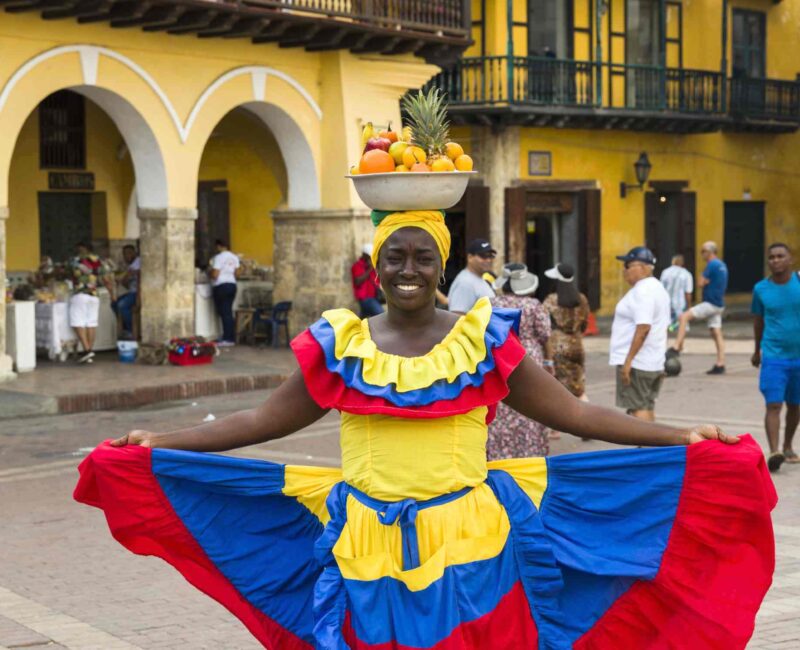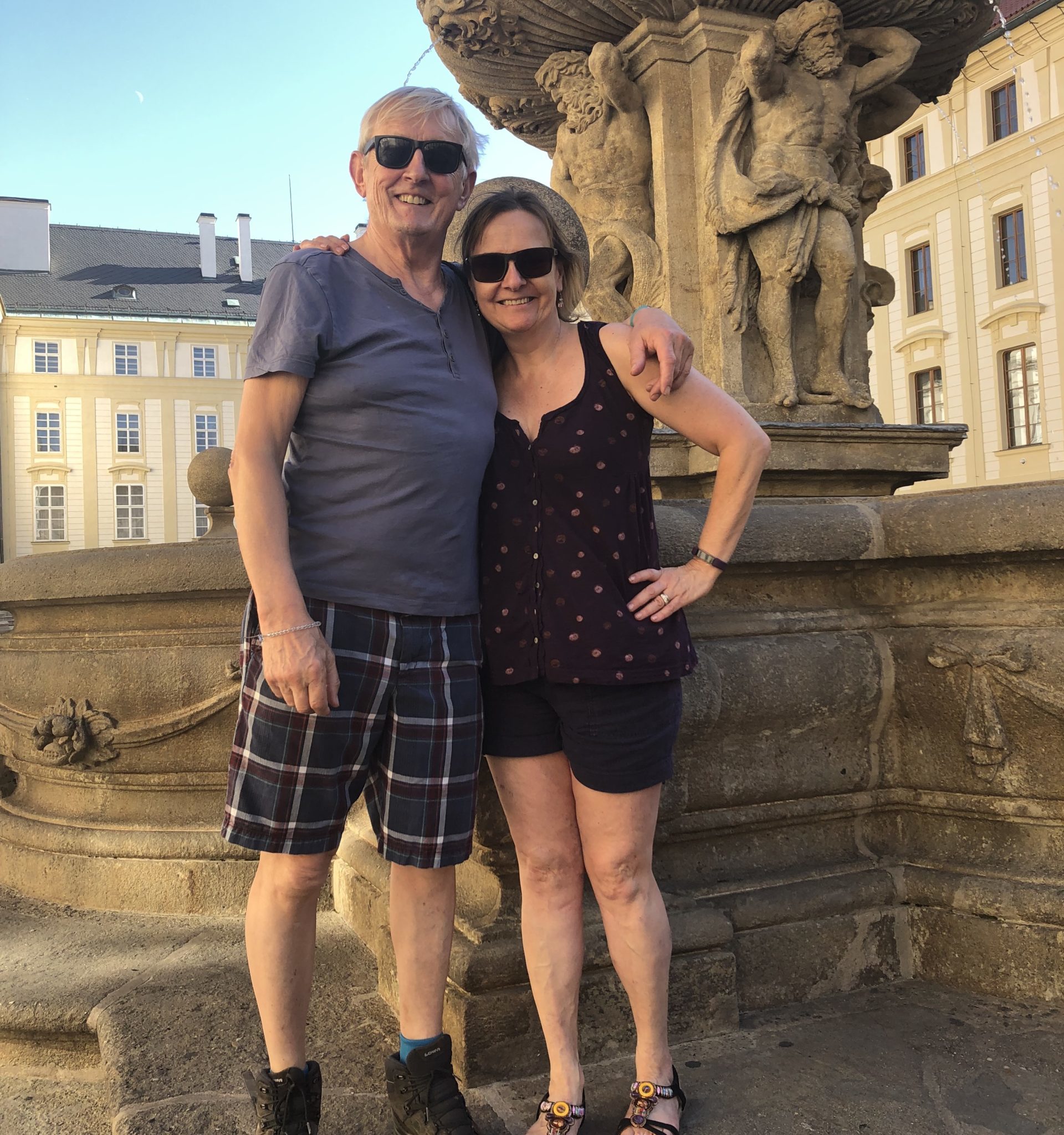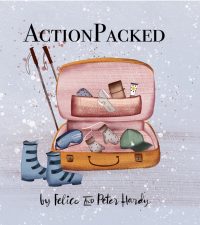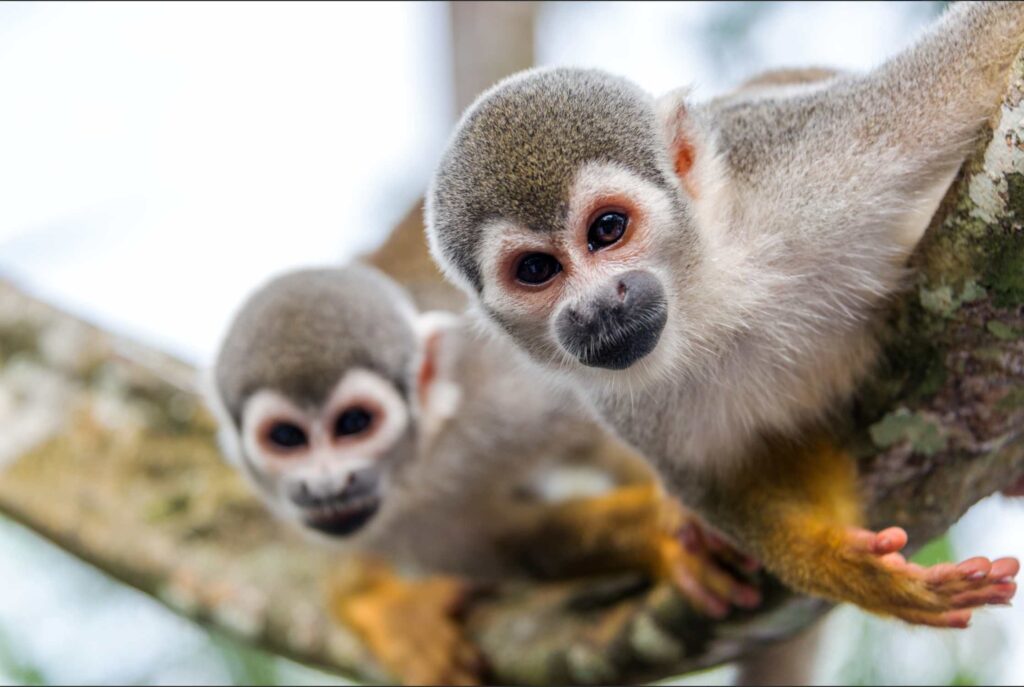
Amazon monkeys
Peter Welcome to our travel podcast. We’re specialist travel writers and we’ve spent half a lifetime exploring every corner of the world.
Felice We want to share with you some of our extraordinary experiences and the amazing people we’ve met along the way.
Peter This week, we’re in Colombia or to be more exact, in the coffee zone, the fruit bowl of this enchanting and ever-surprising South American country where we’re talking to New Zealander, Bruce McLean. Bruce fell in love with the landscape, the culture, the food and his wife here. He now runs a boutique tour operation. Bruce, welcome to the show.
Bruce Thank you very much, Peter. Pleasure to be here.
Peter Now, my first question for you, as an expert on Colombia as you are…and a tour operator in Colombia, is that 30 years ago Colombia was generally considered to be the most dangerous destination on Earth. It was a reputation that had its foundation a full 20 years previously, and it reached its zenith in the heyday of Pablo Escobar, the world’s most famous narco-terrorist, who with a fortune, it’s said, of some 64 billion dollars, became the the richest drug lord of all time. Now in 2021, Colombia has transformed itself into a new title: ‘Most sought-after tourist destination in the Americas.’ However did this come about? Who took the cocaine, the first C, out of Colombia?
Bruce Well, where to begin? How did that all happen…the transformation? Well, there’s the old saying that every cloud has a silver lining. The cloud was obviously Pablo Escobar, a very evil man who murdered over 3,000 people including a planeload of people at one stage, including families, babies, everybody on board…slaughter. And you’re right, he was a very wealthy man, the second wealthiest man in the world. But how the transformation started was with backpackers. Because backpackers, being young people they are adventurous, they want to try different things, that sort of stuff, they want to explore. Colombia has been one of those places where backpackers also want to go and say, ‘Yeah, I’ve been there’ when other people haven’t. ‘I’ve seen that, you haven’t.’ They all want to one-up on other people. That’s sort of how it began, that’s my feeling.
The backpackers started to come, they started going here and there and that sort of stuff, found this amazing country full of beauty, so many attractive locations, landscapes, its abundance of wildlife, birds. You know, we’ve got the most variety of birds in the world, the largest variety of butterflies, second most bio-diverse country in the world next to Brazil, which is obviously much larger than we are. But, yes, it started with them sharing their photos and telling other people about it. And that’s sort of how I think it just started from there, just carried on and more people wanting to go.
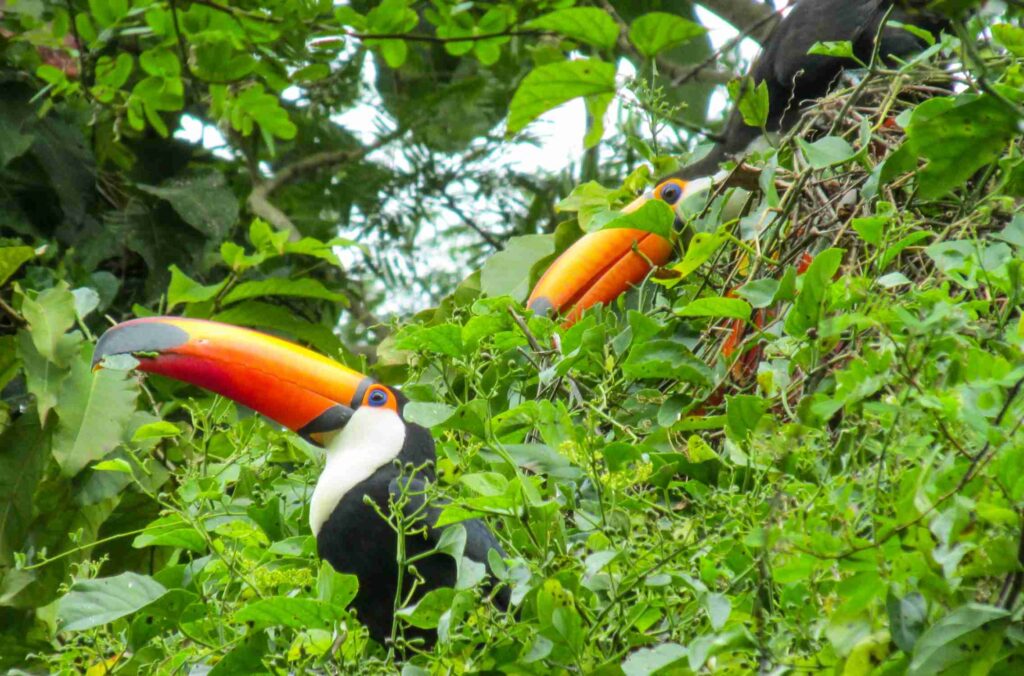
Felice Backpackers have had a huge effect on the opening up of the country to foreign visitors, but presumably the usual dangers of getting mugged or pickpocketed are still out there?
Bruce I think it depends on the situation where you are. I think it’s the same case regardless of what country it is, you don’t walk down those dark alleys if it’s not well-lit, if it’s a lonely street. Security-wise here, you don’t really walk on the street with your phone out. If somebody were to steal it, that can pay for the food and everything for a family for a month.
Peter But is it much safer than it used to be? I fell in love with Colombia many, many years ago. I thought it was one of the most beautiful places I’d ever been to and I was hitchhiking my way through South America and I ended up in Bogotá. I remember then in my early 20s, I guess, being invited somehow to a really smart evening party in a luxurious apartment block. I got talking to this slightly older girl who was, I think, a banker or someone in advertising or something like that. I think she invited me out to dinner. It must have been that way around because I didn’t have any money at all.
Anyway, we left the apartment where there were liveried waiters serving out ice-cold cocktails and canapés to I guess Bogotá’s business finest. And she shut the heavy door behind us and immediately she delved into a giant shoulder bag and produced a huge silver-barrelled revolver. She broke it, checked that all six chambers were loaded, snapped it shut, and then pressed the button on the elevator. I looked at her in stunned amazement and she just shrugged. She said ‘It’s the way it is here. You always have to be alert, especially in underground car parks.’ Now, the world’s moved on since those days, but is it really safe for the visitor?
Bruce Yes, that’s all depending on where you go. For us, where we provide our tours and the locations are safe areas. There’s always going to be those little people your pick pockets and that sort of thing there’s everywhere. As far as getting robbed at gunpoint, that can happen in every country. To be honest with you, is a little bit more dangerous now than it was before Covid, because obviously there’s a lot more people, hundreds of thousands, if not millions, who don’t have work, who haven’t been working for so long. We’ve also got approximately 1.5 million of Venezuelans who have come into the country over the last couple of years. Most of them don’t have work. So there’s a case of a lot of people desperate to feed their families. It is basically just to survive.
Don’t go out and get drunk. I think these stupid things – don’t go down those dark alleys; if it looks like there’s a lot of gang activity, then don’t walk down there. It’s a safe place. There are things that can happen. I’ve been pickpocketed twice. You’ve got to be aware of what’s happening around you. But it’s also to try and avoid those places that have a bad reputation, which everybody knows where these places are. It’s safe to travel here for sure.
Felice Yes, I think you’ve just got to be sensible.
Peter Follow the normal rules of behaviour in a foreign country, a country that you don’t know well.
Bruce Absolutely. You know I lived in Sydney for 17 years and there are places I wouldn’t go. I remember there was an area that police wouldn’t go down unless they’re four cars, four police cars at least. There’s places everywhere in the world and Columbia has them just as everywhere else. The difference here as well is that the big armed groups, those like Narco Trafficante, which are all the same, whether they’re paramilitary or the guerillas or whatever, they’re all just after money and an easy life. They are based in dense forest or in small towns and remote areas, so that’s not where we send our travellers. It’s unfortunate that not everybody can go there, but that’s just unfortunately how it is. The government hasn’t got control over those areas.
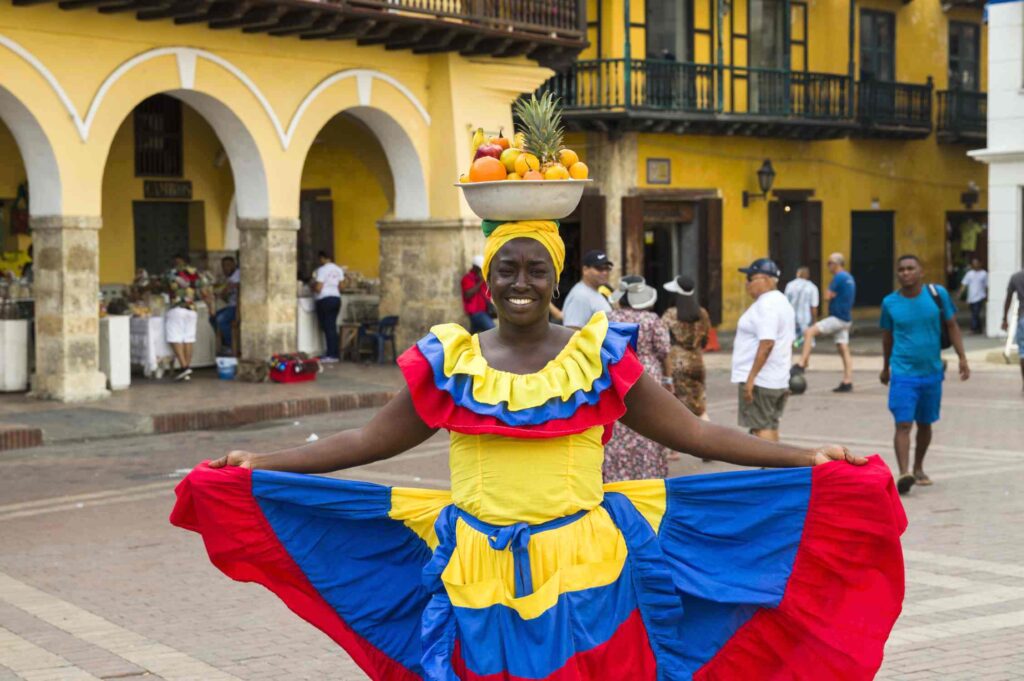
Cartagena Palenqueras
Felice How did you end up living in Colombia in the first place?
Bruce My story starts in 2009. I came here to visit my sister; she’s a missionary in Bogotá, she’s been over 25, 27 years, something like that. So I was here for three months, I got to visit a lot, I got to see and experience a lot of Colombia. I got to the Amazon, San Agustín with the tombs and the stone statues and sculptures dating back thousands of years. I got to the Pacific coast, I got up to the north, the Caribbean, the coffee zone obviously where I live now, I just fell in love with everything. Every place I went was just amazing. Just the natural beauty, the culture, every different location is a different culture. Different people wear different clothing, they have different food. Like I don’t think Colombia is one destination – it’s more or less like 30 destinations that you want to try and visit but obviously you can’t go in one experience. You’ve got to come two or three times. It’s an amazing place.
But that’s when I first fell in love and I met a girl as is a common story. I was living in Sydney at the time. I went back to Sydney and I was lucky enough that Paula followed me back there a few months later. And that’s where we stayed for a number of years. We got married in New Zealand. My mother actually married us in her garden – a nice memory to have. And we took many trips to Colombia in the time that we lived in Sydney. So it was a case of every time we came we knew we were going to come and move here, we knew we were going to live here, we just didn’t know when.
Then we just bit the bullet really and just ‘If we don’t go now, when are we going to go?’ We were going to go when we were retired. What are we going to do? So let’s just go now. And so that’s what we finally came here. We lived in Bogotá for a while. I love Bogotá, but a little bit cold – hot in the sun and then cold in the shade. Because Paula’s from the coffee zone, her family’s here, so now I’m so happy to call this paradise my home. It just has everything; everything except for the beach, but it’s only a couple of hours away. So it’s not that bad.
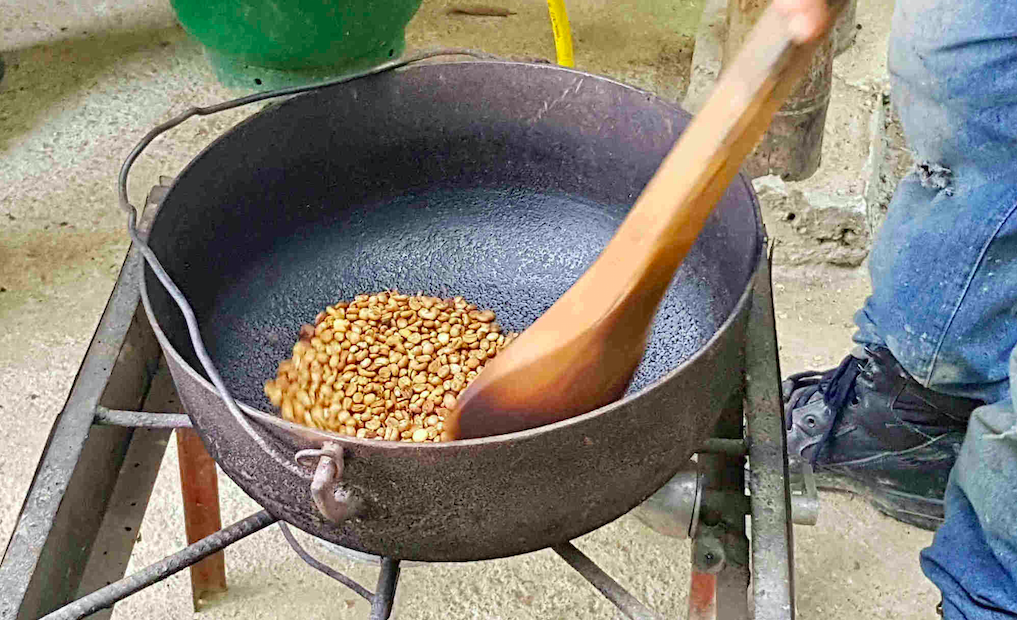
A moment from the coffee tour
Felice What is the coffee zone and where is it exactly?
Bruce The coffee zone also some people call it the coffee triangle, it’s not far from Medellín or from Bogotá. So it’s generally a flight, about a 40-minute flight from either one. But where I live, there’s actually a tunnel getting built that’s going to take us directly, well not directly but close to Medellín. So that’s going to take the road trip down from five and a half hours from here to Medellín to three or three and a half hours, which is going to mean that everybody, I believe, is going to take this road and this is going to be the new direction for traffic as opposed to the flights, even though the flights are only 40 minutes it’s from Bogotá. So somebody coming from Medellín here, international travellers who have a decent amount of luggage, they’ll be going to Bogotá, then to the coffee zone or the other way around. It’s never a direct flight. The direct flights have smaller luggage holds.
Here it’s just like the heart of Colombia, it’s full of mountains. This is all Colombia, but it’s got plantations of coffee obviously, cacao, platanos, pineapples, mangoes, oranges. Sugar cane is big industry here. This is like the fruit bowl. There’s a variety of vegetables and fruit growing in different areas. But this is just an amazing place.
You would have seen the Jeep Willys from 1945 or from World War 2. After World War 2, Colombia brought a lot of them and that’s because it’s so mountainous here to get through, you have to use a mule which is in between a donkey and a horse. So that’s what they use to get through the mountains. And so the Jeep Willys is the only other thing that can do it. So that really here is like the public transport in the small towns. So you’ll see Jeep Willys with maybe a dozen people inside, another half a dozen on the back and another half a dozen on top, along with luggage and bags and stuff. And it’s part of the culture, it’s just beautiful, it’s awesome, I love it. You just have to come and see.
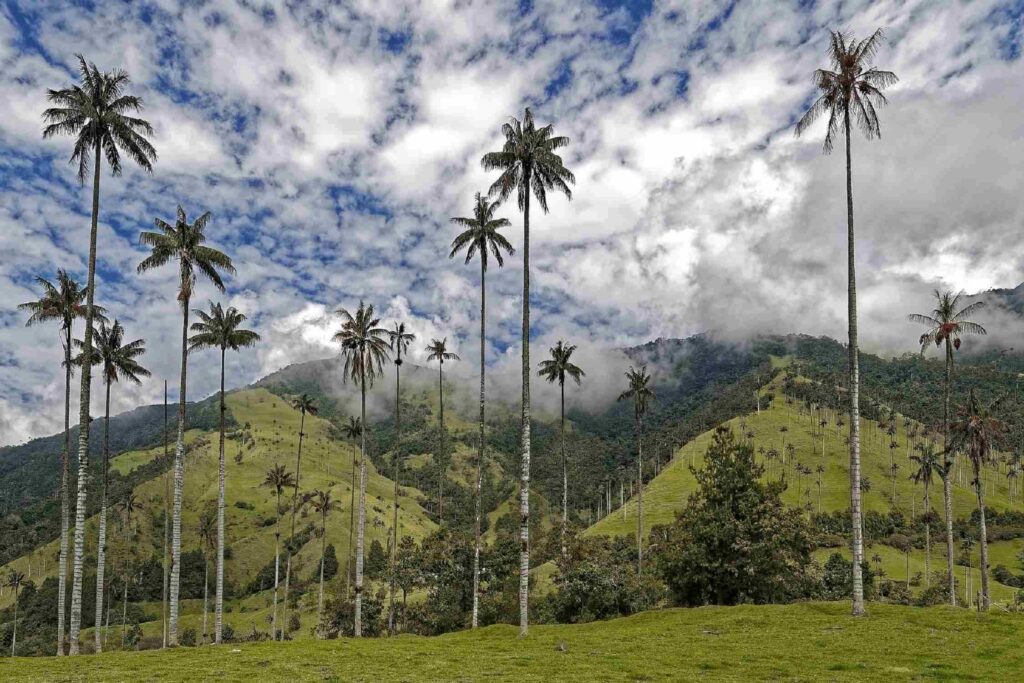
Wax palms in the Cocora Valley
We’ve got these valleys that are just beautiful. We’ve got the tallest wax palms in the world here, Cocora Valley, the Salento, there’s heritage towns, colourful architecture, colonial architecture. It’s just an amazing place.
Felice What is a Jeep Wills? Is it a sort of bus or van?
Bruce No, the Jeep Willys is a jeep, it’s from World War 2. Then the US Army, they had all these extra jeeps afterwards and Columbia bought them. There’s also a chiva here, which is a bus, which is the same as people have gone to Mexico before, know the same sort of bus, colourful things. Sometimes you get a few people on there and they’ll just start some music and they’ll just start singing and it can become, you know, a bus trip from one place to another, it becomes a party. It’s an experience. The music is just everywhere here as well. I love it, absolutely love it.
Peter So if you’re coming from another country and you know nothing about Colombia, and they’re coming on one of your tours how do they choose what to see? There’s so much to see over a huge area? How do you do that really in two weeks or three weeks?
Bruce You can’t do it in two or three weeks. But we can choose some places. What we’ve created on our website a form to fill out which has just got very basic descriptions. So it might be like Santa Marta, Cartagena, it might be Rosario Islands or jungles, monkeys, and different areas.
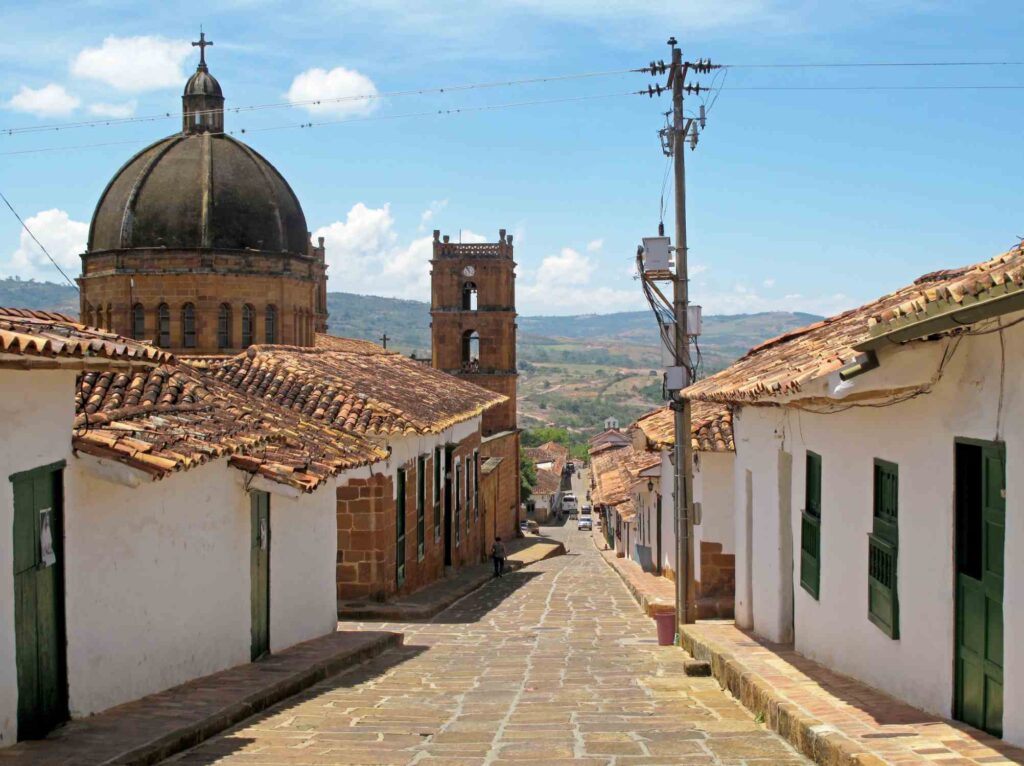
The town of Barichara
So if you’re interested more in the cultural side of things, if you want to see 400-year-old towns, then you tick a box with Villeta or Barichara. If you want to go to rock paintings, which are 12,000 years old, then they’ll be available. Amazon obviously, then jungle and walking and night hikes and day hikes, fishing for piranha. But there’s a case of telling us a few different things that you’re interested in. At that point, we will actually send you a number of videos on the different locations, just short videos, short basic videos – the videos still don’t include everything that’s available. And from then after that, we them schedule a chat and based on what you’re interested we will explain everything to you.
For me, I think to see everything, you’re going to be wanting to be here a few months, but nobody has that – or very few people have that – time or that budget, really. So it’s a case of a number of trips and it is a case if you’re able to do a number of trips, then we can organise things that are closer together. So you’re not losing that time and transport, you don’t want to be spending a couple of hours at the airport and then to fly somewhere near, another hour or two to transfer you somewhere else. It’s a case of organising the logistics and everything to maximise your time here. And we don’t want people tired. For me, I hate going on holiday and rushing to do everything, waking up at 4am or 5am to catch the next flight to get somewhere else to do it. So that’s a big thing for me to organise everything so people are rested, they’re enjoying it, they’re happy, they’ve got wonderful experiences and not just thinking, ‘OK, we’ll look at the camera later and try to remember what we did.’
Peter Are we talking about small groups of people with a guide?
Bruce We only do private tours, private tours, small groups. I’d say 80% is just couples; probably a good 60–70% would be retired over the age of 60. It’s not a demographic we aimed for. We never wanted to do group tours anyway because we don’t feel that one size fits all and people always want to change something. All our packages are customisable. It is often a case that we can actually change that package if we have accommodation mid-tour, if they don’t mind spending that little bit extra, OK, we can stay another day here. Or if you wanted to go change the direction we can do that, we can accommodate. That’s the good thing about doing the private tours.
Felice If people wanted to go hiking in the Amazon jungle, would you take them there?
Bruce Absolutely. It’s not a problem at all. We have some eco lodges in the Amazon jungle and depending on where you like, where we put you as to what experiences you can take. But at all of the eco lodges we provide a night hike and a day hike. If you want to do more than you can, we can go camping in the jungle and we have to sleep in a hammock because you don’t want to really sleep on the ground because something might…a snake might come across you. So it really is a little bit more comfortable. We’ve got hiking everywhere as well; Colombia is an amazing place to hike.
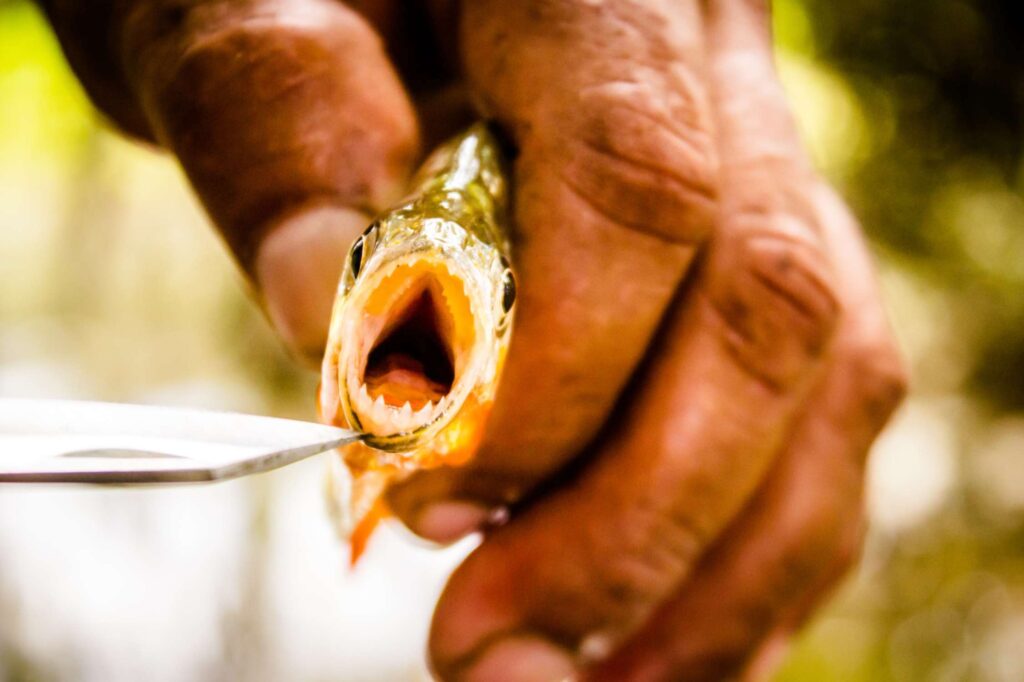
Piranha from the Amazon
Felice And you also go fishing for piranhas?
Bruce In the Amazon, absolutely. Piranha fishing is not as glamorous as it sounds. You don’t even have a rod; you have like a fishing line and they’ll put a bit of meat on it because obviously that’s what they eat. You just chuck it in there and depending if it’s a bit more blood then obviously you get a few more around. But absolutely. Then depending on where we lodge you and if it’s an eco lodge, if you’re actually on the Amazon River you can’t go out on a boat at night because obviously there’s no street lights because it’s the Amazon River so it’s illegal to go out at night on a boat in case you crash into another.
But on the side rivers, the tributaries, it’s easier. So we can actually if we put you in eco lodge there, then you can go out on a boat at night; we can take you and you can go hunting for caiman, which are like a little alligator. In reality, you won’t be doing it, the guide will be doing it – and they’ll catch a caiman for you and you’ll be able to hold a little alligator in your hands. It’s quite an experience. But you know, the small ones that don’t bite too much.
Felice How big are they?
Bruce The ones I try to catch…we’re looking at is about 30 centimetres, that’s what they catch, 30–40 centimetres. So what’s that? About a foot I suppose. If you’re talking about full size, they can get up to a couple of meters. So similar to alligator, but smaller.
Felice They wouldn’t bite your finger off or something like that, would they?
Bruce They could, absolutely. But if it’s a small one, the guide will be holding it and then pass it to you. Safety is first, so you probably don’t put your fingers in the mouth. I wouldn’t want to do that; maybe behind its head and on the tail in a safe place, that sort of thing.
Felice When you go fishing, what sort of boat do you go in?
Bruce Basic, like a canoe. A big canoe, more or less will be what it is – with those long, long tubes on the back of the motor so they can raise the propellers out of the water if need be – because of course, depending on what time of the year, what season it might be, water levels might be high or low.
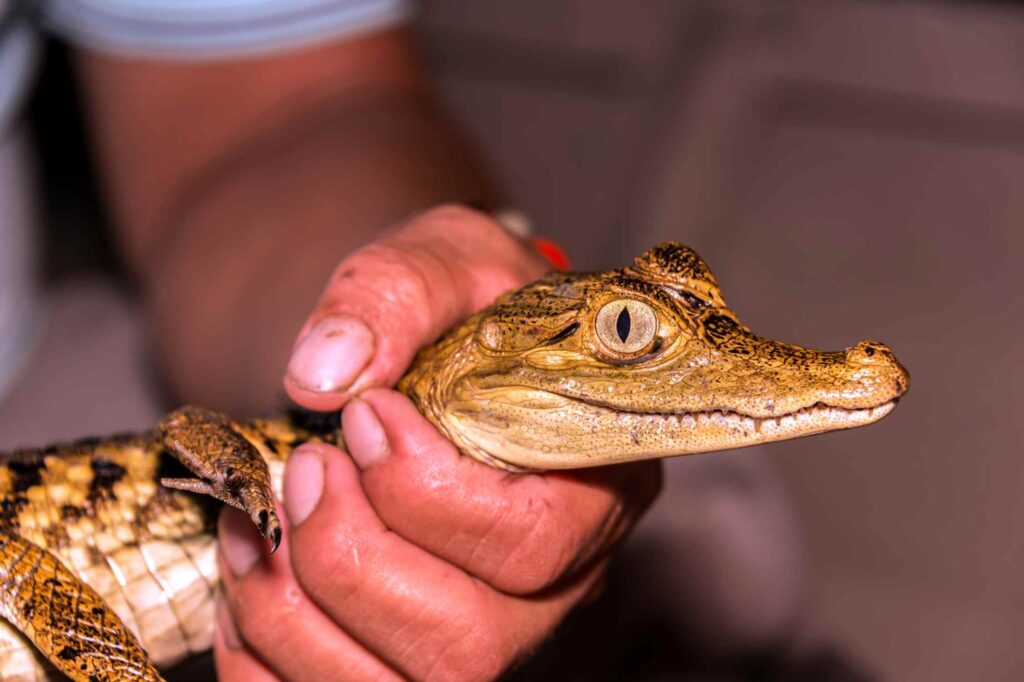
Holding a caiman
I remember the first time that I went there, our boat got stuck before we even got to the eco lodge. So there’s a guide and a couple of other people there who were going to the lodge as well, who were workers. So they had to get out of the boat and to slowly push us through over these same banks. Every now and then you’d see them jump up because one of us stood on something that he wasn’t sure what it was, because there’s obviously the caiman, there’s piranha, there’s also stingrays, there’s different animals there that can bite. Everybody got there in one piece but it was really interesting.
Peter In complete contrast to something like the Amazon basin, there’s beautiful former colonial towns like Cartagena. I remember very well, it has got really lovely old buildings and I’m sure there are more beautiful towns than that.
Bruce As you said, Cartagena, beautiful. The heritage area, the historic zone, it’s 200, 300 years old, some 400-year-old buildings, they’re amazing. The fort there is wonderful to walk around. It’s not just that – a lot of people go to Cartagena for the beaches, the Rosario Islands, crystal clear waters super for snorkelling, diving if you wish as well. You can stay on overnight there. Other wonderful towns, Villa de Leyva, which is 400 years old and also close to Bogotá…about three hours from Bogotá. The cobblestone roads, wonderful buildings. Once again, if you want to see something that’s just spectacular, Barichara is probably the must-do-must-see location. Every year it’s voted the most beautiful town in Colombia. It’s heritage is just exactly as it was 400 years ago.
Peter If you’re looking for an activity holiday?
Bruce Over any location?
Peter Any location.
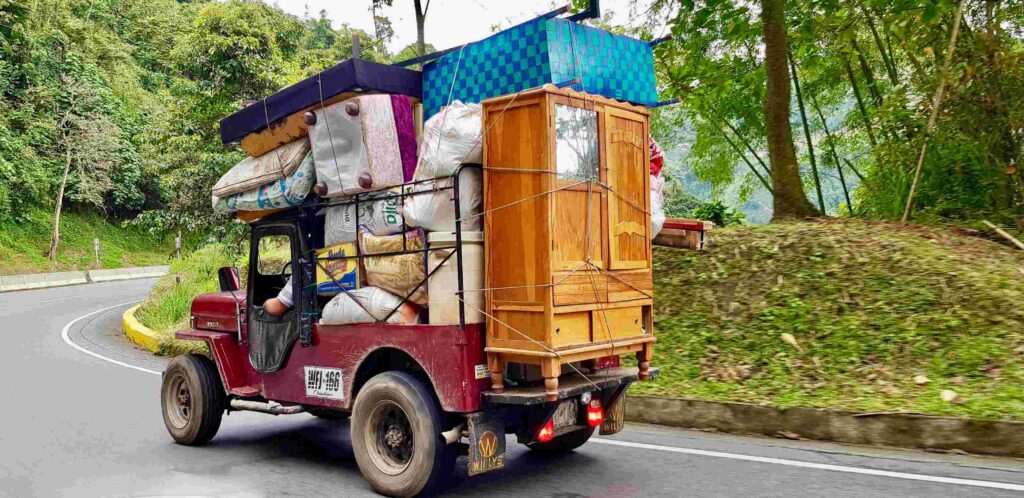
Jeep Willys moving house
Bruce Ok, well, from Medellin, a couple of wonderful towns to visit, both coffee heritage towns, so that’s colourful, you’ll see the buildings red, blue, green, yellow, wonderful streets surrounded by plantations of coffee and everything else. Guatapé is about an hour and a half from Medellín, quite bit quite a bit closer, I would say. A good 99% of visitors who visit Medellín would go to Guatapé as well. There’s a massive rock called El Peñón; you can actually climb up 700-odd steps right to the very top.
We also have offered helicopter rides to and above that area because it is just sensational, the lake is just beautiful. You can go out there on a boat as well. A beautiful place to stay as well as to Gautapé for a night or two. It’s just got amazing buildings of not so much heritage-wise, but colourful, very colourful. It’s also got clay images painted on the actual bottoms of the building. And it’s not just flat-painted, I should say, it’s almost it’s like, how would you describe it? You might see a Jeep Willys or chiva. Like I was saying, we see campesinos, which is a hardworking people, the peasant farmers, or houses and that sort of stuff, more or less three centimetres thick these paintings, these sculptures that are actually stacked onto the buildings – it’s beautiful, it’s just different. In the coffee zone we have coffee tours, cacao tours, Trapiche tours, my favourite tour at the moment is a Trapiche to a panela factory.
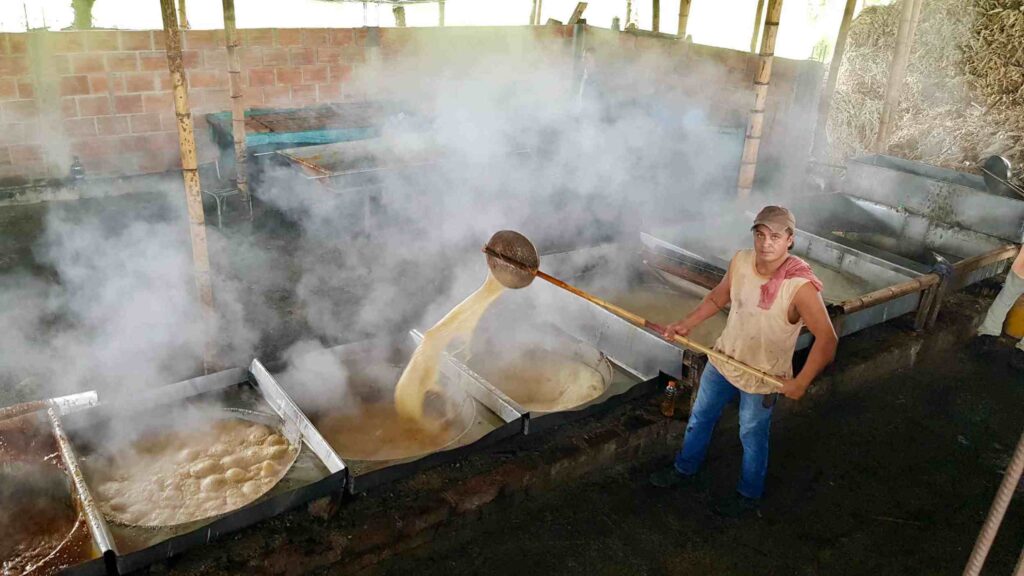
Trapiche panela sugarcane
So Colombia is actually the second largest producer of panela in the world. For those who don’t know, it’s made from a different sort of sugar cane. So it’s not the same sugar cane as what normal processed sugar or raw sugar is made from. It’s a different one. That is a very artisanal method in production, it’s cut by hand with machetes in the fields. Then it’s put onto a mule that will then then go to the Trapiche, which is the factory. From there it’s pressed and all the liquid comes out. The stalks are then used for a fire which goes all day 5am to 7pm at night. From there, all the liquid is actually scooped up and poured into another pan and then to another pan, and another pan. And it’s just boiling hot. The whole time it’s just steaming boiling hot. And each time they’re scooping it, it’s getting more and more pure. It’s cool and it’s so interesting and you can get close to it without getting too dangerous.
If you’re in another country, you’d be two metres away behind a glass wall. Here you can actually get up close and you can see it, you can scoop it up yourself. Obviously, there’s a bit of common sense and you don’t put your hand in, but that’s one of my favourite tours.
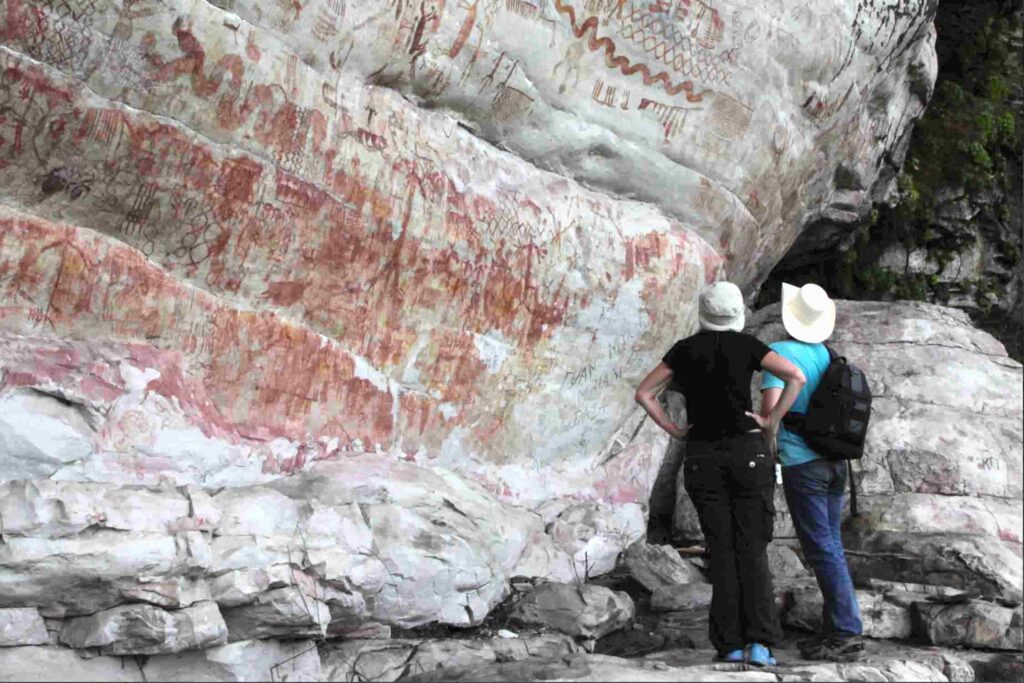
Rock paintings at Cerro Azul El Guaviare
If you want something really action-packed, if you are interested in history, San Agustín – the tombs and everything there, ranging from hundreds or thousands of years, all the statues. Guatapé, that is one of my favourite destinations just now, as well. The 1,000-year-old rock paintings which actually have horses that were the paintings of the horses that were before the Ice Age, dating from from 12,000-plus years to 400 years because the cattle paintings and cattle on there as well, which were only introduced by the Spaniards.
This whole range of of things that you can see in the handprints and you can actually you’re seeing in action things that were 12,000 years ago, that is real true history, as well as meeting indigenous people who still live there, who still have the same language, the same songs, music. You learn to dance, try their food. And that’s just one of the regions. Acandi, not too far from Guatapé, actually, a place that is not on the tourist map yet where you can go for leatherback turtles. I love this one at night. It’s only certain times during the year, giant leatherback turtles come up the beach and go and lay their eggs. You can watch all of this happening. And once again, because of this country and not necessarily others, you can be right there with that turtle, watching. If you’re getting the timing right, the follow morning you can watch little baby hatchlings breaking free of the eggs and then scurrying down the beach. So you got just a mountain of things to do here. Sort of why I think you can’t do it in a couple of weeks.
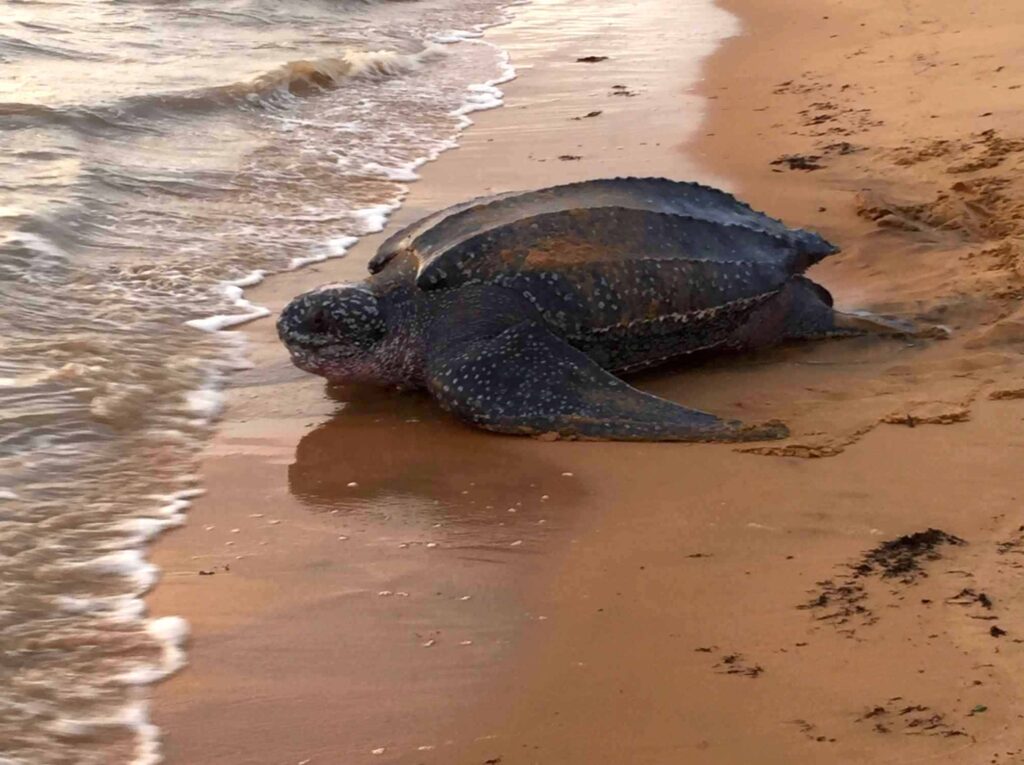
A leatherback turtle
Felice You told me Colombia is also in the Caribbean. Is that right?
Bruce Yes, that’s right. So that actually part is Caribbean as well, we’re saying. And it’s actually like on the border with Panama. From there, we’re going up to Cartagena, it’s about a five-hour drive, more or less. We just fly Toreson because we don’t like to take up too much time driving places if we don’t need to. So we have that and then in Cartagena there, you’ve obviously got Mompox, which you may have heard of. It’s like stepping back in time and Mompox, a beautiful little town. Then you got Santa Marta still in the Caribbean.
We’ve got Tayrona Park, a national park. Cabo San Juan is in Tayrona Park, which is a beach where you can actually sleep in different locations as well – in hammocks if you want. I can’t sleep in hammocks, I’ve learned that. But, you know, many people do.
Peter They say that the secret to sleeping in a hammock is to trail one foot down. But every time I tried that, the other one follows it. I agree with you; I find it completely impossible.
Bruce It is not about not being comfortable, because I can get comfortable in a hammock. It’s just actually falling asleep. I can’t do that.
Felice Why is that? Because you’re worried you might fall out?
Bruce No, it’s not like that because you feel secure. We have a hammock here where I live, on our balcony, and I’ll just go there and rest for 10 or 20 minutes, but I can never fall asleep. It’s just the position, I guess. But there’s other situations where you might not have a choice between a hammock or a mattress on the floor and the hammock is the best choice.
Peter I’d take the hammock every time because, as you said earlier, it’s quite possible something might come along and crawl over you in the night. I’d rather be in the hammock.
Bruce True. There are locations like that.
Peter So the standard of accommodation overall for your guests, is that sort of what you describe as three-star, four-star? Or it varies enormously?
Bruce Most places, three- to five-star. It just depends on what they would like to enjoy. There are locations, such as in the Amazon, we’re thinking one- or two-star, or an eco lodge, you know, so it can still be very nice, but very, very basic. And the Pacific coast, very nice but basic. If we’re talking El Guaviare, with the rock paintings – three-star, if we’re going up north into Sierra Nevada – then it depends on how far north you want to go. If you want to stay with indigenous communities then there’s basically your hammock. But generally most places there’s three- to five-star accommodation available, some six-star.
Peter And the food varies accordingly?
Bruce Absolutely. But generally the food’s always good. It can be basic to astounding. But for me, the basic food, the traditional food, is just delicious. It is so much variety as well. There’s typical meals, different locations, the typical meals, traditional meal and a paisa, which is huge. And that has beans, it’s got some meat, it’s got platano, it’s got so many different things, it’s got some pork belly. It’s a meal which a lot of people can’t finish and a lot of people will take home. I should make a point: Colombians can finish this. They’re smaller people than me, but they will still finish this at lunch. You know, and it’s really surprises me. Lunch is the biggest meal.
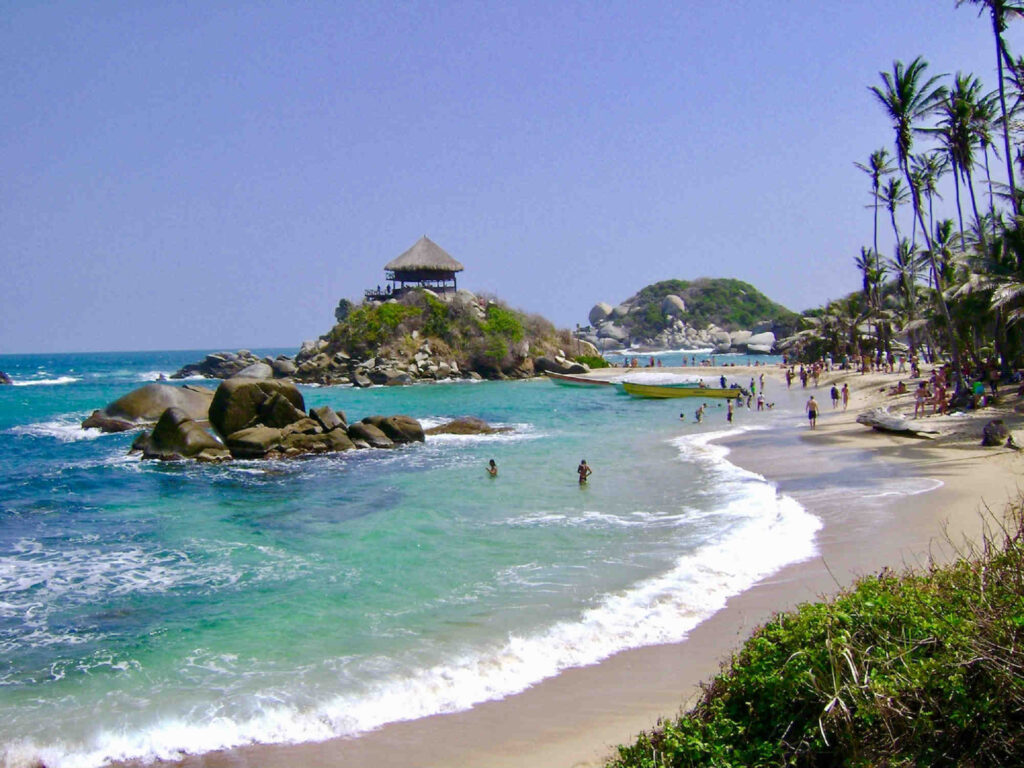
On the beach at Cabo San Juan
Felice If people want to book with you, how did they do that? What’s your website?
Bruce Website is www.bnbcolombia.com or www.bnbcolombiatours.com which is the name of our business. One just directs to another so it doesn’t matter which one you choose. From there you get a contact form or the get a quote page, you can write down all the things that you’re interested in, along with ticking those boxes as to which destination you would like information. Either way, from there, we’re a phone call away.
Peter Bruce McLean, thank you very much indeed for appearing on the show and we wish you the very best of luck with your venture and adventures in the future in Colombia.
Bruce Thank you very much, Peter. Thank you, Felice. It’s been a pleasure talking to both.
Peter Hopefully meet you in real life. One day we’ll come find you.
Bruce Excellent. I’ll be here.
Felice That’s all for now. If you’ve enjoyed the show, please share this episode with at least one other person! Do also subscribe on Spotify, i-Tunes or any of the many podcast providers – where you can give us a rating. You can subscribe on Spotify, Apple Podcasts or any of the many podcast platforms. You can also find us on Twitter, Facebook and Instagram. We’d love you to sign up for our regular emails to [email protected]
Also see our episode Will Community Travel Have A Positive Impact?
© ActionPacked Travel
![]()
- Join over a hundred thousand podcasters already using Buzzsprout to get their message out to the world.
- Following the link lets Buzzsprout know we sent you, gets you a $20 Amazon gift card if you sign up for a paid plan, and helps support our show.
